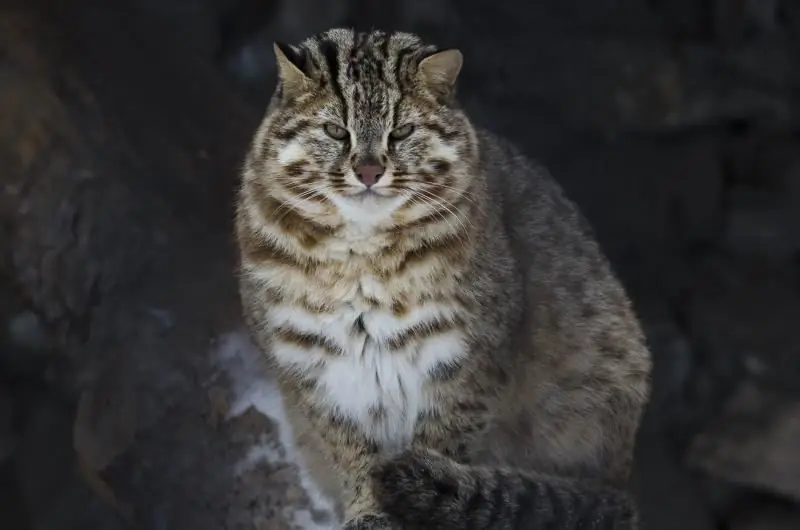
Table of contents:
- Author Bailey Albertson [email protected].
- Public 2024-01-17 22:26.
- Last modified 2025-06-01 07:32.
Far Eastern forest cat: the mystery of the Amur land
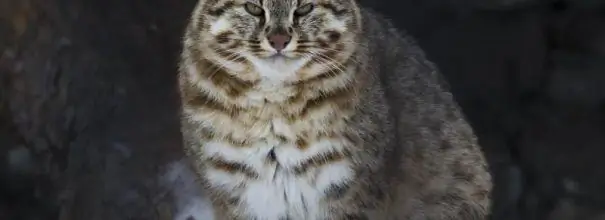
Far Eastern forest cats are animals that are in no hurry to declare themselves to the world. To this day, these secretive wild cattle remain elusive to scientists. So much so that the latter cannot determine the exact number of Amur cats. Therefore, for safety reasons, the animals were listed in the Red Book and provided with protection at the state level.
Content
-
1 What does an Amur cat look like
1.1 Photo gallery: portraits of Far Eastern wild cats
-
2 Far Eastern forest cat in its natural environment
-
2.1 Habitats of the Amur forest cats
2.1.1 Video: Bazhenov's rating - Far Eastern forest cat
-
2.2 Habits of the Amur cat
2.2.1 Video: Far Eastern forest cat hunts
- 2.3 Family matters
- 2.4 Video: call of the taiga - forest cat
-
-
3 Taming the Far Eastern Forest Cat
- 3.1 The behavior of the Amur cat in captivity
- 3.2 Conditions of detention
- 3.3 Amur cat nutrition
What does an Amur cat look like?
Genetically, the Far Eastern forest cat is the closest relative of the Bengal cat. But it lives much to the north of this spotted purr.
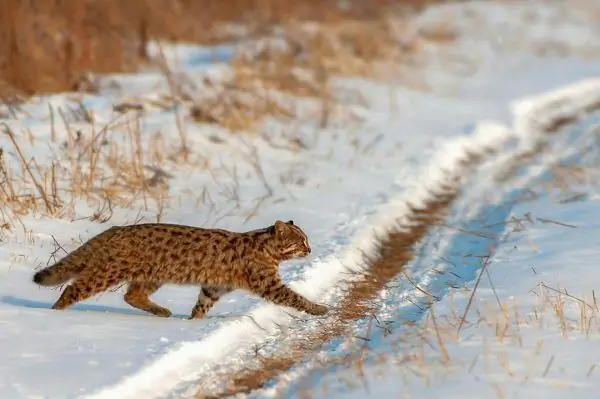
Amur cats have an appearance similar to Bengals.
Among the representatives of the feline family in Asia, the Amur cats are the smallest. Their weight reaches 5-9 kg, and their height at the withers is no more than 40 cm. Females are more graceful and fragile than males. The length of the body of the Far Eastern cat is about 95 cm, and one third is occupied by a fluffy and at the same time thin tail. The maximum size of this part of the body of the Amur purr is 38 cm.
Other specific features of the appearance of a wild cat from the vastness of the Far East are:
- neat head of small size, slightly elongated forward;
- rounded ears, completely devoid of tassels (thanks to which the animal cannot be confused with a lynx);
- wide bridge of the nose with a large, brownish-red nose;
- long, thick vibrissae;
- deep-set, round yellowish-brown eyes;
- rounded, powerful chin;
- wide legs, and the hind legs are longer than the front ones;
- strong jaw with long, sharp canines.
In general, the body of a Far Eastern cat is distinguished by muscularity and density, and grace and excellent flexibility are noticeable when walking.
The fur coat of this "savage" is worth a separate discussion. The cat's fur consists of wool and undercoat, which allows the animal to survive in extreme frosts. Moreover, the length of the main pile often reaches 5 cm, which creates additional conditions for a comfortable existence in a harsh winter.
The fur color of the Far Eastern forest purr resembles that of a leopard due to oval brownish spots all over the body. For this, the fluffy was nicknamed the leopard cat. And because of the sandy and brownish tone of the fur coat, the Chinese associate the Amur cat with the ancient coins of the Celestial Empire. And the Han people confidently refer to the animal as the "Money Cat".
On the head of a Far Eastern cat, stripes are observed (vertical on the forehead and horizontal on the “cheeks”), and along the ridge such streaks, interspersed with spots, merge into three wide dark lines along the ridge. There are rings on the breast and tail, and in the upper part of the body they are reddish, and in the caudal - dark brown.
For Amur cats, coat color changes with age. So, at a younger age, the spots and rings are noticeable very clearly, and with the entry into the sexually mature period, the coloring becomes more uniform. This allows animals to perfectly camouflage themselves in fallen leaves and in tree crowns.
Photo gallery: portraits of Far Eastern wild cats
-

Amur cat sits and looks down - The harsh climate also left its mark on the character of Amur cats - reserved and serious
-

A pair of Far Eastern cats sitting in a shelter - Far Eastern cats are very secretive animals
-

Amur cat hisses, opening its mouth with fangs -
Amur cat - albeit small, but still a predator
-

Amur cat stands in the snow and looks back - Far Eastern wild purrs are very impressive animals
-

Amur cat sits in a snowy sedge - Amur cats seem "fat" because of the dense wool
Far Eastern forest cat in its natural environment
Despite the fact that the Amur wild cats are listed in the Red Book, these animals are quite widespread throughout the Far East. Such purrs are known in China, Japan, and even the Malay Islands. Since the species is prone to migration, Far Eastern seals have been spotted in regions such as Indonesia, Java, Sumatra, as well as Burma and Nepal.
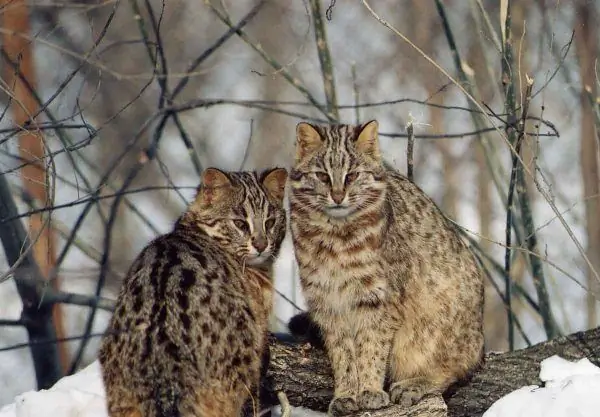
Amur wild cats have a wide range of distribution
The habitats of the Amur forest cats
These wild purrs live most freely in protected areas - in protected areas where hunting is prohibited. Although, by and large, such animals have never been shot.
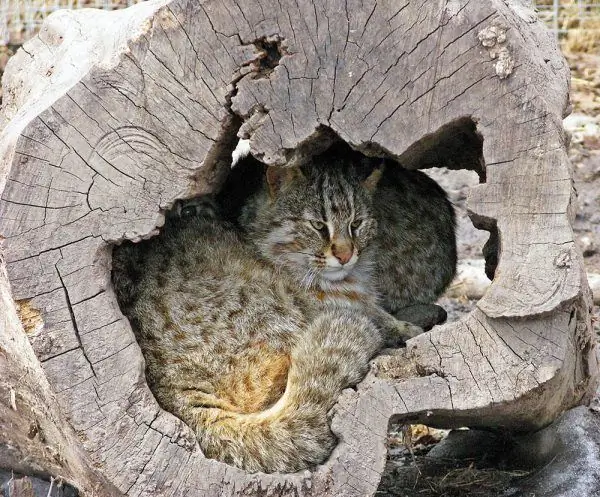
Amur cats make themselves refuge in the trees
With a certain amount of luck, you can meet a Far Eastern cat in the Ussuri and Kedrovaya Pad nature reserves, as well as in the protected areas - Lazovskaya and Khankaiskaya.
The animal prefers to settle in thickets along rivers and lakes, floodplain and swampy lowlands. The Amur cat does not shun a mixed or deciduous forest, and if it is not located in the vicinity, it can climb the mountains. But the cat still does not climb high, since a lot of snow accumulates between the rocks. And because of its modest size, the fluffy falls into deep snowdrifts and cannot hunt. In the taiga, Far Eastern forest seals rarely appear, again, due to the poor passability of such a thicket.
As soon as it snows and a thick snow cover forms on the ground, Amur forest cats hide in shelters. Hollows in trees, crevices in stones and abandoned burrows of other animals can become such. Only with the appearance of a solid ice crust on the snowdrifts, which would withstand the weight of the animal, cunning mustache go out again on the path of hunting and conquering new lands.
But the secretive purrs prefer not to get to know a person, in every possible way avoiding the prying eyes of researchers and tourists. If the collision could not be avoided, the Amur forest catofey will hasten to hide in a tree or in the nearest bush.
Video: Bazhenov's rating - Far Eastern forest cat
Amur cat habits
Far Eastern forest cats are considered one of the most secretive and timid representatives of their family. In addition, like its other wild relatives, this animal is nocturnal. And in the daytime it spends time in its "nest" or a secluded place chosen as a den.
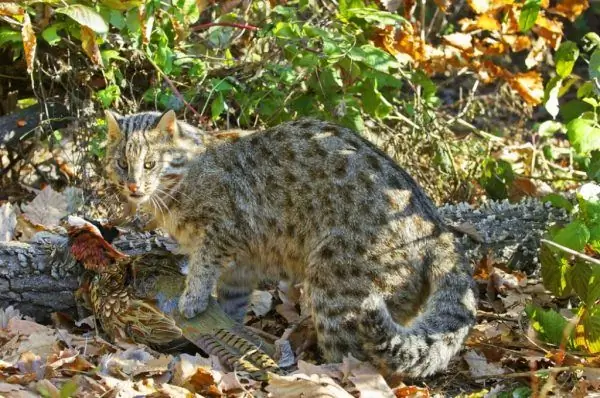
Amur forest cats are dexterous hunters
Interestingly, the Far Eastern forest cat may have several “houses”, and none is left unattended while it is summer. In winter cold, the animal chooses the warmest and most comfortable of its dwellings, where it hides from the bitter frosts.
Amur cats lead a solitary life, gathering in groups of 5-6 individuals only for the time of mating. After that, each animal goes into its possession, which it jealously guards. The area of hunting grounds, as a rule, is up to ten square kilometers.
But who the leopard cat loves to hunt:
- vole mice, rats and other small rodents (depending on where they live);
- squirrels, martens;
- muskrats, hedgehogs;
- birds (from jays to falcons);
- hares, ferrets.
Far Eastern cats are distinguished by their bold and assertive disposition, so they are not afraid to fight even with young roe deer and small deer. At the same time, these brave purrs are not averse to feasting on bird eggs and fish from nearby water bodies.
The tactics of hunting Amur cats involves an ambush attack. Sometimes one well-aimed throw is enough for the beast to get the victim in its tenacious paws.
Video: Far Eastern forest cat hunts
Family matters
When the time comes to acquire a family (approximately in the middle of March of each year), the Amur cats, leading the lives of loners and individualists, unite around the female they like and begin to fight for the “lady's heart”.
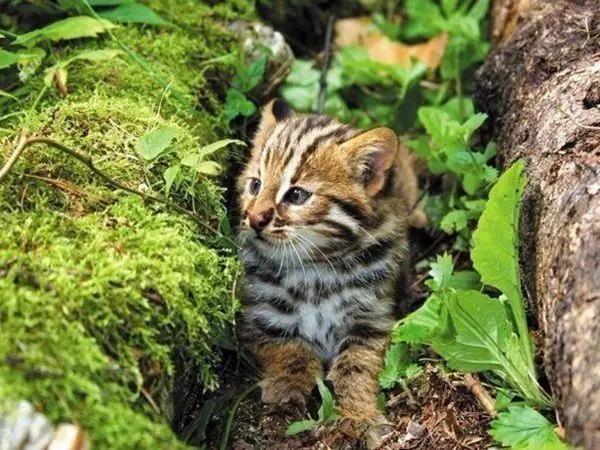
Far Eastern kittens are very beautiful and cute cubs
According to the results of the competition, the cat remains pregnant and carries cubs for 67-72 days. By the end of spring, the long-awaited offspring appear in the den of a married couple of Far Eastern purrs. Kittens are born blind, and there are no more than three or four individuals in a litter.
Ten days later, the eyes of the babies open, and the little ones begin to actively explore the territory of the den. After one and a half to two months, the mother cat already allows her cubs to leave the "nest". The father of the family also takes part in the upbringing of the offspring. The cat brings prey and protects housing from other predators.
By the fifth or sixth month, young animals become independent and already know how to hunt. At this time, the matured purrs leave their parental home and begin to explore new territories. At the same time, puberty in young Amur cats occurs at 12-16 months.
Far Eastern cats live on average 9-16 years old, differing in strong immunity and the ability to deftly escape from dangers.
Video: call of the taiga - forest cat
Taming a Far Eastern Forest Cat
Since Amur cats are only slightly larger than an ordinary domestic murk and look about the same, many exotic lovers have an irresistible desire to get such a fluffy in possession. The difficulty lies only in the fact that the blood of wild predators flows in the veins of this mustache. And the call of the ancestors can wake up at any moment.
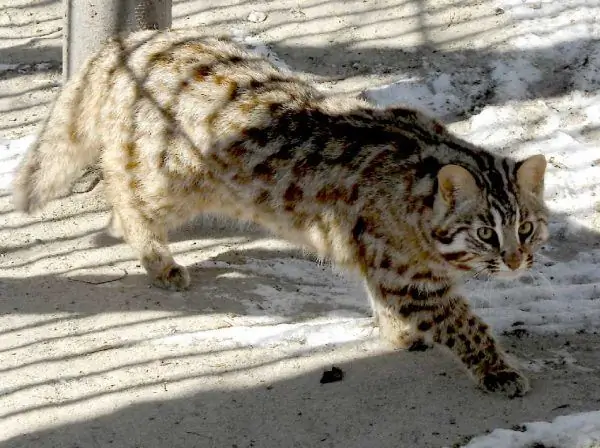
Amur cats are almost impossible to train
The behavior of the Amur cat in captivity
Wild Far Eastern cats have long been brought to zoos for living. However, despite everyday contact with people, these animals remain secretive and uncommunicative.

Far Eastern forest cats are independent and wayward
No attempt has been made to tame or train these furry predators. Moreover, such undertakings often ended in injury to the "trainers". Indeed, if it is impossible to run away from people, the Amur cat instantly turns into an aggressor. And as you know, the fearlessness of an angry mustachioed cat has no boundaries.
When purchasing a Far Eastern forest cat for living at home, you need to remember the following:
- such a kitty does not go "into the hands";
- wild murka does not eat "from the palm";
- the spotted cat will sleep during the day and wander around the territory allotted to him at night (if not retrained);
- during the mating period, aggression will intensify, because of which the animal can announce the house with heart-rending screams.
It is also important that even individuals taken at the age of three months become wild as they grow older and tend to return to their natural environment by any means.
In the author's opinion, the Far Eastern forest cat remains a dangerous predator, even being taken from a “home-type cattery”. After all, there are cases when these animals attacked even domestic dogs in hungry years. Fearless murkas need large spaces, otherwise one should be wary of manifestations of aggression towards others. Therefore, the author's opinion is unambiguous - a wild animal must live in natural conditions. Otherwise, both the animal and the person who decide to acquire an exotic cat for the sake of status suffers.
Conditions of detention
Since this animal is listed in the Red Book, the official sale of Amur forest cats to private hands is prohibited. However, there are cases when animals still end up in the same dwelling with a person - they gave the zoo or picked up a hunter friend. Cases of smuggling are also not excluded. And then the owners need to decide on the living conditions of a wild predator in a house or even an apartment.
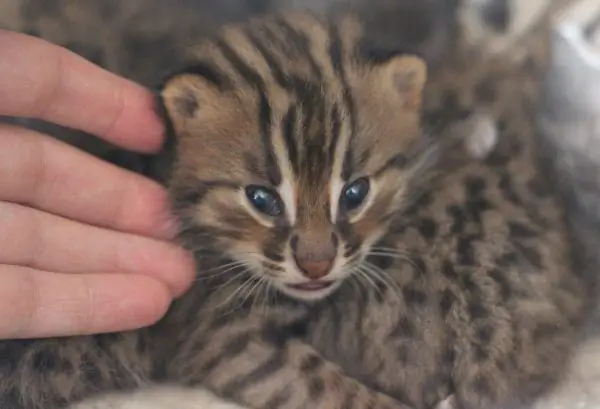
It is advisable to keep Far Eastern forest cats in closed enclosures
Experts unanimously recommend limiting the living area of the Far Eastern forest cat to a spacious aviary. It should contain devices for climbing and jumping (timber, tree trunks and cuts, shelves), as well as a convenient "nest". This can be made in the form of a house like a doghouse. In addition, you need to take care of the litter box for your pet, filling the toilet with sawdust or sand.
If the predator somehow turned out to be a resident of a city apartment, the main thing is that there are no children in it. And even without this, the owners cannot be insured against accidents, even if the Amur purr was taken as a child. It is important to provide the wayward pet with a spacious separate corner, so that in this place the pet feels comfortable and safe during the hours of solitude.
Amur cat nutrition
In the wild, Far Eastern cats cannot always afford to eat food every day. It is worth remembering this when dealing with an animal that comes to a person as a pet.
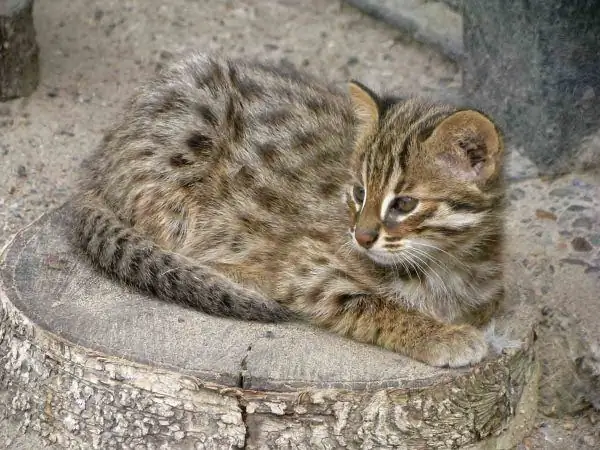
Nutrition of the Amur cat at home should be close to the diet in the natural environment
A wild cat from the banks of the Amur should be fed once a day, preferably at the same time. The diet should include poultry, lean beef, veal and rabbit. To maintain healthy teeth, it is important to feed the animal with mice and uncut bird carcasses.
In addition, once a week, you can pamper your pet with the following food:
- raw chicken or quail eggs;
- sea fish (both fresh and boiled);
- boiled vegetables (pumpkin, carrots, zucchini).
But you should not give porridge to your pet - they can cause fermentation in the intestines and disruption of the digestive system. Milk, bakery products, alcohol, spices, fried and salted foods should also be excluded from the menu.
The animal must have access to clean drinking water.
Since the Far Eastern cat is a wild animal, it is important to exclude food intake for the purr once a week in order to relieve the gastrointestinal tract and prevent obesity.
Amur forest cats are difficult and daring animals from the Far East. These animals have been cherished for a long time, and for lovers of exotic, fluffy beauties become a welcome trophy in their home nursery. However, do not forget about the negative aspects of keeping a Far Eastern cat at home - the aggressive behavior of the purr and criminal liability for the possession of the Red Book animal.
Recommended:
Pallas' Cat: Lifestyle Of A Cat, Habitat, Keeping In Captivity, Photo, Is It Possible To Tame A Wild Kitten
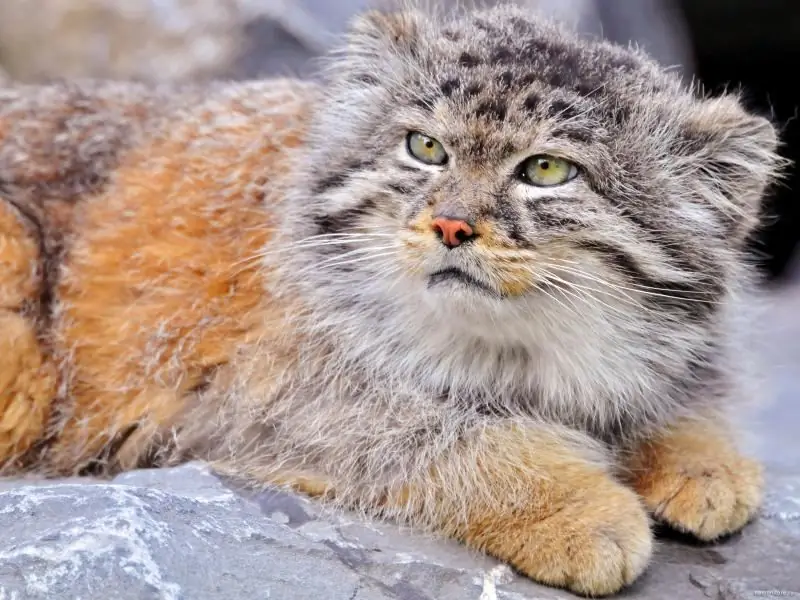
Wild cat manul: a description of the appearance of the animal, its life, character and behavior of the manul in the wild and when kept in captivity. Power features
Velvet Cat: Appearance, Habitat, Behavior And Nutrition, Keeping A Sand Cat At Home, Photo
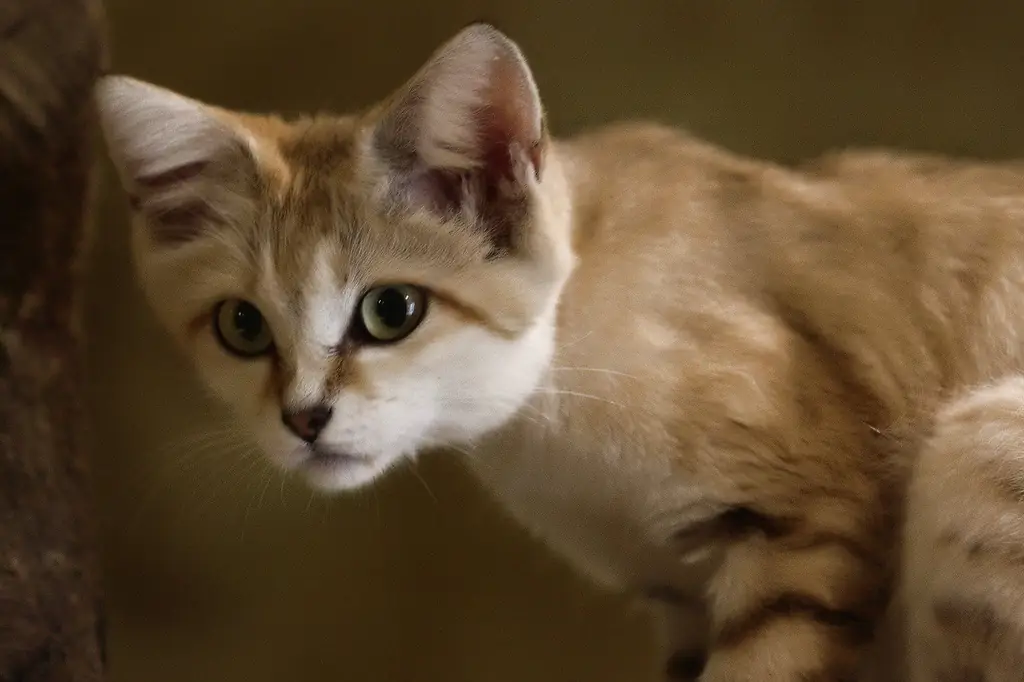
What is a dune cat. Where he lives. What kind of life he leads. Is it possible to domesticate it. How to keep at home. Parenting tips
Steppe Cat: Lifestyle, Habitat, Keeping In Captivity, Breeding And Feeding Of The Cat

The appearance of a steppe cat. Habitat. Life in the wild. What do spotted cats eat? Reproduction and life expectancy. Wild cats in captivity
Andean Cat: Description Of The Breed, Nature And Habits, Habitat, Keeping In Captivity, Photo
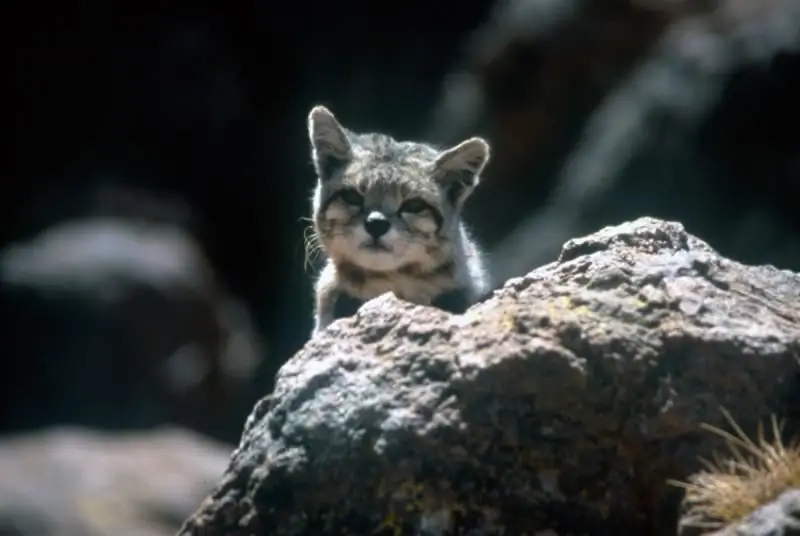
How this rare cat was discovered. What does an Andean cat look like, where it lives in nature, what kind of life it leads, can it be kept in captivity
Black-footed Cat: Lifestyle And Habitat, Distinctive Features, Keeping In Captivity
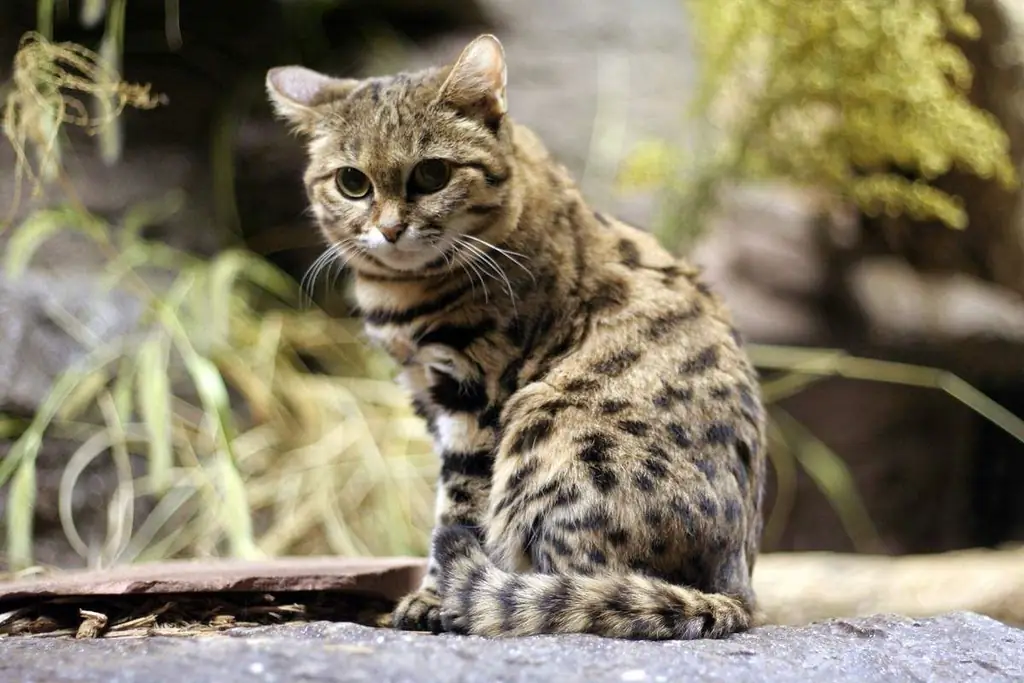
Where does the black-footed cat live, what distinctive features it has, how it hunts and reproduces, how to keep the cat at home
